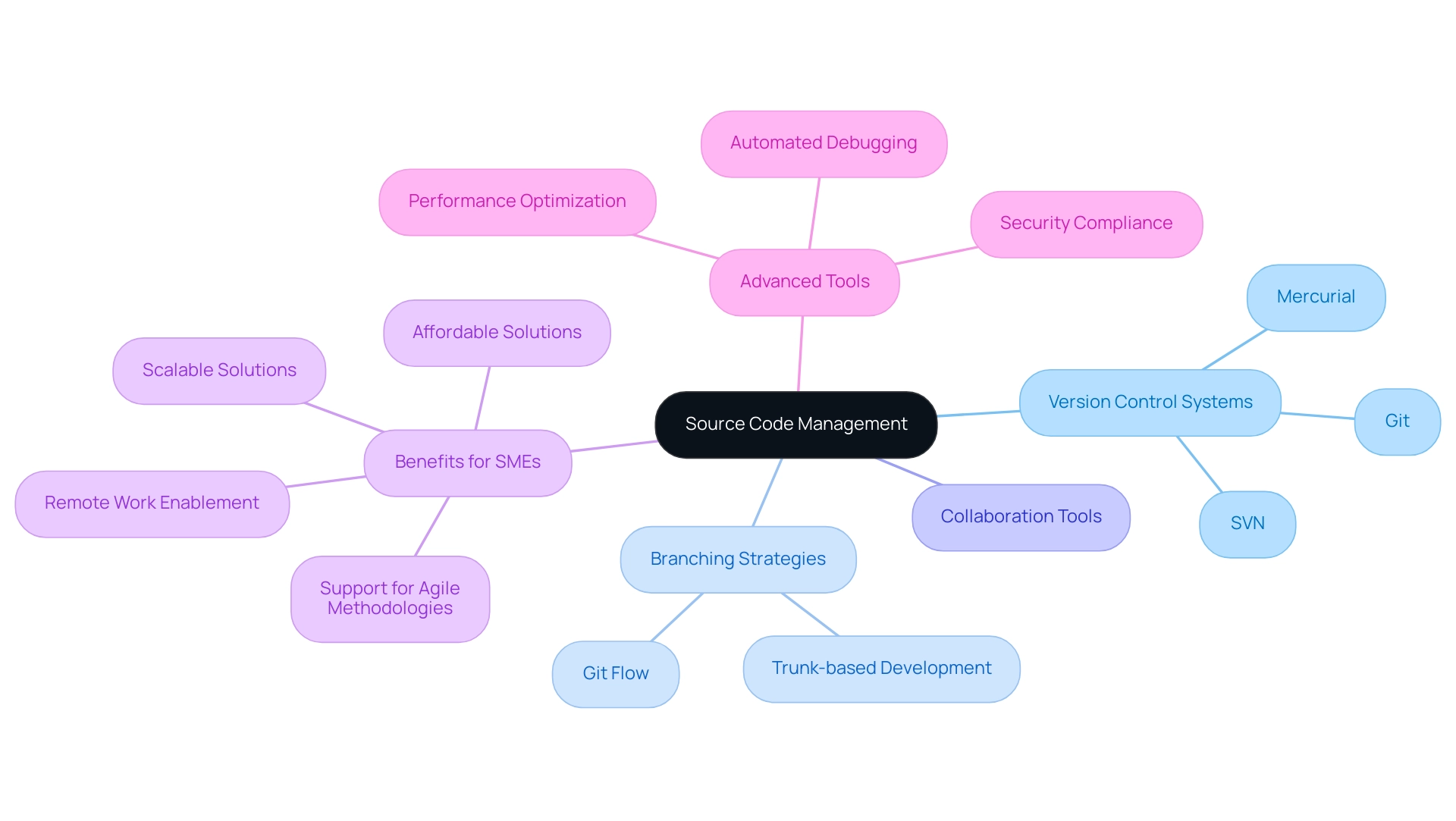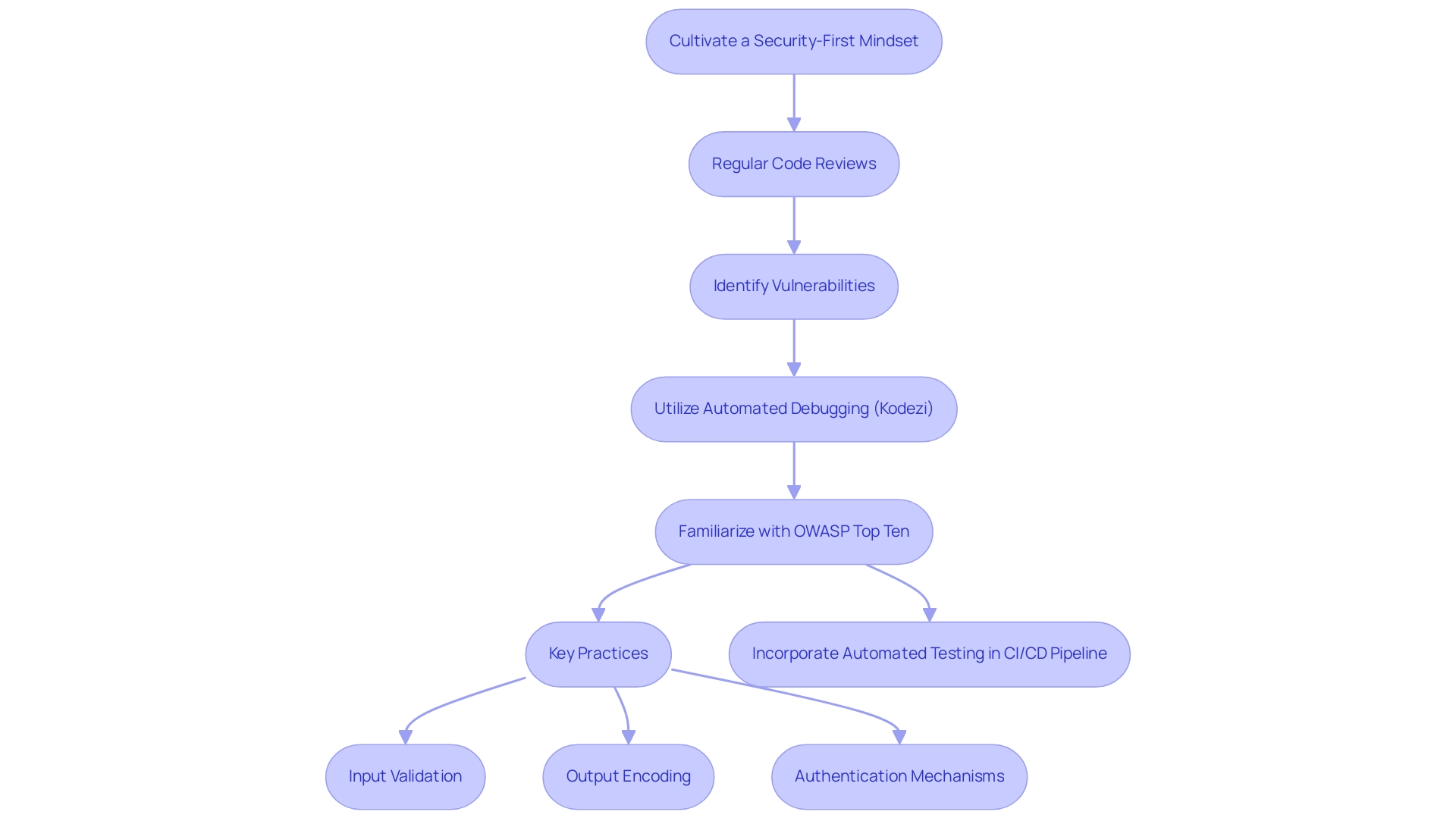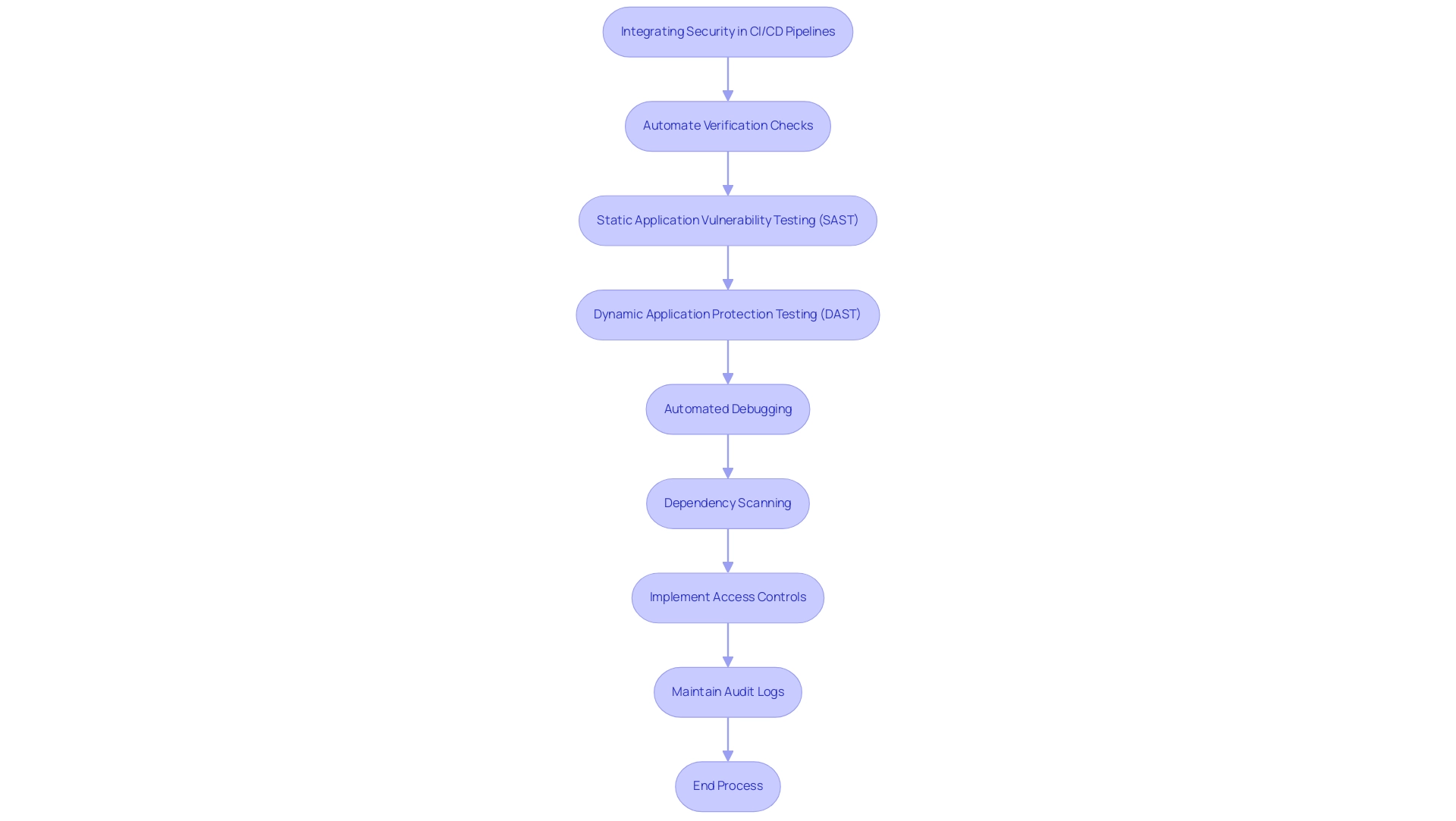Introduction
In the ever-evolving landscape of software development, the significance of effective source code management and secure coding practices cannot be overstated. As organizations increasingly adopt no-code platforms and agile methodologies, the need for streamlined version control and proactive security measures becomes paramount.
By harnessing advanced tools like Kodezi, development teams can not only enhance collaboration and productivity but also safeguard their applications against vulnerabilities. This article delves into essential strategies for:
- Implementing robust source code management
- Embedding security within CI/CD pipelines
- Fostering a culture of secure coding through training and awareness
Discover how these practices, coupled with innovative solutions, can transform your development process and lead to more secure, efficient, and high-quality software.
Understanding Source Code Management
Source management (SCM) is a crucial methodology for overseeing changes to source throughout the software development lifecycle. It employs version control systems (VCS) such as Git, SVN, or Mercurial to meticulously track modifications, foster collaboration among developers, and preserve a comprehensive history of changes. In an era where 58% of companies are building data analytics apps using no-code platforms, the importance of efficient SCM practices becomes even clearer, as these platforms rely on effective version control to manage code changes seamlessly.
Start by choosing a VCS that aligns with your group's specific requirements, as this choice significantly impacts efficiency. Familiarize your group with established branching strategies like Git Flow or trunk-based development, which streamline collaboration and ensure a more organized workflow. Regularly committing changes with descriptive messages enhances traceability and accountability within the codebase.
Additionally, utilizing tags to signify important releases can facilitate smoother transitions during development cycles. The benefits of effective SCM are particularly pronounced in SMEs, which, while accounting for a smaller market share, are projected to grow at a higher CAGR due to their need for affordable and scalable solutions. Agile methodologies, supported by SCM tools, enable remote work and collaboration, making them essential for modern development teams.
Furthermore, utilizing advanced tools enhances this process by incorporating automated debugging to swiftly resolve issues, optimize performance, and ensure security compliance. For instance, the tool's ability to identify and fix performance bottlenecks not only enhances application responsiveness but also supports adherence to programming standards, ensuring that the software remains robust and maintainable. With the CLI, groups can auto-heal codebases in seconds, dramatically enhancing productivity and enabling developers to concentrate on innovation instead of troubleshooting.
By minimizing the time spent on pull requests through effective code corrections and collaborative tools, the platform fosters a more unified work environment. Corporate user license access enables sharing of reports with all members without restrictions, promoting transparency and collective understanding of the development process. By mastering these foundational principles alongside the platform, your team will not only enhance productivity but also reduce conflicts, ultimately leading to a more cohesive development process.

Implementing Secure Coding Practices
To effectively implement secure coding practices, it is essential to cultivate a security-first mindset throughout the software development lifecycle, particularly when reviewing application source code. Start by performing regular reviews of the application source code with a specific emphasis on identifying vulnerabilities; this proactive strategy is crucial in detecting issues early. With an estimated 90% of incidents and breaches including a phishing element in 2019, addressing these vulnerabilities through secure coding practices is crucial.
Utilize Kodezi's automated debugging capabilities on your application source code to improve your skill in spotting potential problems and swiftly addressing them, especially in recognizing performance bottlenecks and vulnerabilities. Familiarity with secure coding guidelines, such as the OWASP Top Ten, is essential as it outlines the most pressing risks faced by developers of application source code today. Key practices in managing application source code include:
- Ensuring robust input validation
- Output encoding
- Implementing effective authentication mechanisms to mitigate risks
The rise in mobile ransomware threats, with a 54% increase in new mobile malware variants in 2019, illustrates the real-world implications of vulnerabilities, underscoring the necessity of secure coding practices. Moreover, incorporating automated testing for vulnerabilities within your CI/CD pipeline is highly advisable, enabling you to analyze the application source code for weaknesses prior to deployment. As mentioned, 96% of organizations think they would gain from automating safety and compliance processes, strengthening the case for automation in improving protection.
By prioritizing safety in your programming practices with tools like Kodezi, which functions as an autocorrect for scripts rather than merely an autocomplete, you not only reduce the risk of breaches but also greatly enhance the overall quality and efficiency of your application source code.

Best Practices for Code Review
To conduct effective reviews, it's essential to establish a clear and structured process that outlines specific guidelines. Focus on key areas such as:
- Adherence to coding standards
- Identification of logic errors
- Detection of potential security vulnerabilities
As Derek Ashmore, Application Transformation Principal at Asperitas, notes, 'This includes naming conventions, formatting, and architectural best practices. Reviewers should be aligned on these to provide consistent feedback.'
Utilizing code review tools like GitHub Pull Requests or GitLab Merge Requests can significantly enhance collaboration, facilitating discussions and tracking feedback efficiently. In today's environment, tools like CLI can autonomously enhance your codebase and resolve issues before they reach production, further elevating your development process.
With a swift 5-minute quickstart and demo available, groups can easily integrate Kodezi CLI into their workflow. A real-world example of effective review implementation is The Browser Company, which adopted stacked pull requests to streamline their review process. This approach allows for breaking large changes into smaller, manageable pieces, fostering easier inspection and collaboration among team members.
Aim for small, frequent reviews of programming, ideally examining no more than 200-400 lines at a time to minimize cognitive load and maximize issue detection. Documenting the review process and outcomes not only creates a valuable knowledge base for future reference but also reinforces best practices. By incorporating Kodezi CLI into your workflow and applying these strategies, you can significantly enhance the quality and protection of your application source code, ultimately leading to improved outcomes in your software development projects.
Integrating Security in CI/CD Pipelines
Incorporating protection for application source code into your CI/CD pipeline is essential for creating a robust and safe development environment. Begin by automating verification checks at each stage of the development process. Start with static application vulnerability testing (SAST) tools, which examine the application source code for flaws right upon commit, enabling early identification and correction.
Next, employ dynamic application protection testing (DAST) during the testing phase to uncover runtime vulnerabilities in the application source code that may not be visible in static analysis. Additionally, include automated debugging features to instantly identify and fix issues in the application source code, providing detailed insights into what went wrong and how it was resolved. Automated debugging is essential for resolving performance bottlenecks, improving code formatting, and ensuring adherence to the latest best practices.
Coupled with dependency scanning tools to monitor third-party libraries for known vulnerabilities, these practices safeguard against potential risks from external sources. Implementing access controls and maintaining detailed audit logs will further enhance your protective stance by tracking changes and identifying unauthorized modifications. By incorporating these protective measures and automated debugging within your CI/CD pipeline alongside the application source code, you significantly reduce the risk of vulnerabilities entering production, thereby safeguarding sensitive data and enhancing overall system integrity.
Considering that customer data is involved in 43% of data breaches, protective groups confront the intricate task of securing this information, especially in contemporary microservices architectures. As noted by Eldad Chai, CEO & Co-Founder, 'Embracing this vision enables groups to respond effectively to challenges and safeguard their data assets.' Moreover, the current trend indicates that many organizations are underperforming despite adopting DevOps practices, highlighting the necessity of advanced CI/CD tools and practices, including automated testing and debugging, to improve security and performance.

Training and Awareness for Secure Coding
To foster a strong culture of secure coding among your development group, utilizing tools such as CLI can significantly boost programming productivity. By independently enhancing your application source code and resolving issues before they enter production, CLI serves as a flexible solution for B2B engineering groups. Regular training sessions focused on secure coding practices, combined with Kodezi's capabilities, create an environment where developers can focus on writing secure code effectively.
Participating in workshops, webinars, and online courses focused on current safety subjects will keep your group informed and skilled. Moreover, a knowledge-sharing platform can further enhance this culture, enabling members to collaboratively discuss vulnerabilities and potential solutions. Integrating a mentorship program where seasoned developers guide less experienced colleagues can also bolster understanding of secure coding principles.
As Stephen Walli, Principal Program Manager at Microsoft, emphasizes, 'The importance of secure coding practices cannot be overstated; it is essential for maintaining the integrity of software in today’s fast-paced development environment.' By prioritizing these training initiatives and fostering an environment of security awareness while utilizing the CLI, you not only elevate your group's competencies but also drastically diminish the potential for security vulnerabilities in the application source code. For those interested in getting started quickly, Kodezi CLI offers a 5 minute quickstart and the opportunity to see a demo, allowing teams to experience firsthand how this tool can enhance their coding practices.
Conclusion
Effective source code management and secure coding practices are vital components in the modern software development landscape. The implementation of robust source code management, supported by tools like Kodezi, ensures that development teams can efficiently track changes, collaborate seamlessly, and maintain a comprehensive history of their code. By adopting established version control strategies and utilizing automated debugging capabilities, teams can significantly enhance productivity while minimizing conflicts and streamlining workflows.
Incorporating secure coding practices throughout the development lifecycle is equally crucial. By fostering a security-first mindset and conducting regular code reviews, developers can proactively identify vulnerabilities and mitigate risks before they escalate. Integrating automated security testing within CI/CD pipelines further strengthens this approach, ensuring that potential threats are detected and resolved early in the process. This not only protects sensitive data but also enhances the overall integrity of applications.
Moreover, promoting a culture of continuous learning and awareness about secure coding principles is essential for sustaining high-quality software development. Regular training sessions, mentorship programs, and collaborative knowledge-sharing platforms empower teams to stay informed and skilled in the latest security measures. By leveraging advanced tools like Kodezi alongside these practices, organizations can build a more secure and efficient development environment.
In summary, the convergence of effective source code management, secure coding practices, and a commitment to ongoing training creates a robust framework for software development. Embracing these strategies will not only lead to higher-quality, more secure applications but also drive innovation and efficiency within development teams. As organizations continue to evolve, prioritizing these essential practices will be key to achieving long-term success in the competitive software landscape.
Frequently Asked Questions
What is source management (SCM) and why is it important?
Source management (SCM) is a methodology for overseeing changes to source code throughout the software development lifecycle. It is important because it employs version control systems (VCS) to track modifications, foster collaboration among developers, and preserve a comprehensive history of changes, which is essential for efficient software development.
Which version control systems (VCS) are commonly used in SCM?
Commonly used version control systems in SCM include Git, SVN (Subversion), and Mercurial.
How can teams choose the right VCS for their needs?
Teams should start by selecting a VCS that aligns with their specific requirements, as this choice significantly impacts their efficiency in managing source code.
What are some established branching strategies that can enhance collaboration?
Established branching strategies such as Git Flow and trunk-based development can streamline collaboration and ensure a more organized workflow during development.
Why is it important to commit changes regularly with descriptive messages?
Regularly committing changes with descriptive messages enhances traceability and accountability within the codebase, making it easier to track modifications and understand their context.
How can tags be utilized in SCM?
Tags can be used to signify important releases, facilitating smoother transitions during development cycles and helping teams keep track of significant milestones.
What role does SCM play in the context of small and medium enterprises (SMEs)?
Effective SCM practices are particularly beneficial for SMEs, which are projected to grow at a higher CAGR due to their need for affordable and scalable solutions, enabling them to adopt agile methodologies and support remote work.
How can advanced tools enhance the SCM process?
Advanced tools can enhance SCM by incorporating automated debugging, optimizing performance, and ensuring security compliance, allowing teams to quickly resolve issues and improve application responsiveness.
What benefits do automated tools provide during the development process?
Automated tools minimize the time spent on pull requests through effective code corrections and collaborative tools, fostering a unified work environment and promoting transparency among team members.
What practices should be followed to implement secure coding?
Key practices for secure coding include ensuring robust input validation, output encoding, and implementing effective authentication mechanisms to mitigate risks associated with vulnerabilities.
How can automated testing contribute to secure coding?
Incorporating automated testing for vulnerabilities within the CI/CD pipeline allows teams to analyze the application source code for weaknesses prior to deployment, thereby enhancing security.
What is the significance of familiarizing oneself with secure coding guidelines like the OWASP Top Ten?
Familiarity with secure coding guidelines such as the OWASP Top Ten is essential for identifying the most pressing risks faced by developers and implementing strategies to address them effectively.




